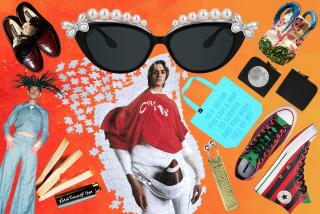Race you to the pricey sculpture
- Share via
MIAMI — New York photographer Charles Thompson, dressed in a cream suit, white shoes and sipping a strawberry smoothie, stood at the entrance to the Miami Beach convention center, just before the noon VIP opening. He was one of several hundred collectors waiting for the doors to open to the largest U.S. contemporary art fair.
Thompson, a tall, blond collector of Russian contemporary art, waited patiently. Around him the throbbing scene at the sixth annual Art Basel Miami Beach resembled the door at Studio 54 on a hot night. Influential Miami collectors Carlos and Rosa de la Cruz huddled with their curator and friends. A tanned man waved his unlighted cigar.
At noon the doors swung open and ladies in Chanel ballet flats and men in khakis surged forward.
“It’s like the running of the bulls in Pamplona,” Thompson wisecracked, pushing ahead. “But more dangerous.”
Within moments, hundreds of eager art shoppers tore around the 200 tony art galleries that had set up shop in the vast air-conditioned hall. Hundreds of millions of dollars’ worth of art filled the walls.
“Perfect for Nantucket,” plummy voices observed. “Hurry, it will be gone in 15 minutes,” others urged.
Skin-care maven Adrien Arpel admired a $380,000 Fernando Botero bronze of a plump ballerina at the Munich Galerie Thomas. “Everyone is scurrying around to get whatever,” she said, waving her hands, piled with diamond rings and bracelets. “My husband wants to know why I spend my life on a diet and want to look at fat-lady sculptures.”
For the next four hours Wednesday, collectors proceeded to rip through the fair, buying up the hot and available. Early sales included PaceWildenstein’s speedy dispatch of large paintings by Chinese artists Zhang Huan and Zhang Xiaogang, for prices the gallery declined to disclose. “Comrades” (2006) by Zhang Xiaogang was bought by Donald Marron’s Lightyear Capital, said Matthew Armstrong, curator of Lightyear’s collection.
“There’s no hesitation, no hesitation,” said Los Angeles dealer Tim Blum of Blum & Poe, rattling off a list of works. “It’s symptomatic of this art market.”
Paintings by Mark Grotjahn and Takashi Murakami were among the almost sold-out roster of artists lining the stand. Blum said he sold between $5 million and $10 million worth of artworks in one day.
At David Zwirner’s booth, Murakami bought Marcel Dzama’s tableaux featuring piles of severed heads and a towering cartoonish creature wielding a white baseball bat.
“It’s so cute,” the artist said, smiling. “I can’t believe it’s still available. I am so lucky.”
Tour de France champion Lance Armstrong cruised the aisles hidden under a blue baseball cap and accompanied by a posse of tattooed friends. Long-haired David Lauren, son of designer Ralph Lauren, zipped around in orange cargo pants while collector and hedge-fund manager Adam Sender made the rounds sporting sandals.
Though many exhibitors reported strong sales during the opening hours of opening day, some said they sensed that a slowdown is inevitable.
“The main effect of the economic situation is that the market is going to be turned from a seller’s market into a buyer’s market,” said Karl Schweizer, managing director of UBS’ art banking division. “I think we are moving in this direction.”
Schweizer said collectors were increasingly rejecting overpriced artworks, sometimes marked up four to six times what a dealer had paid. UBS is the fair’s main sponsor.
“Art is a new asset class in some ways,” said Robert Wolf, chairman and chief executive of UBS for the Americas. “And here it’s in a beautiful setting.”
Said Schweizer: “You have to look at the art itself. The price doesn’t tell you if it’s quality.”
Outside the convention center, two women stood on the steps selling $7 hot dogs smothered in sauerkraut. They said business had never been better, with sales of more than 200 dogs.
More to Read
The biggest entertainment stories
Get our big stories about Hollywood, film, television, music, arts, culture and more right in your inbox as soon as they publish.
You may occasionally receive promotional content from the Los Angeles Times.










